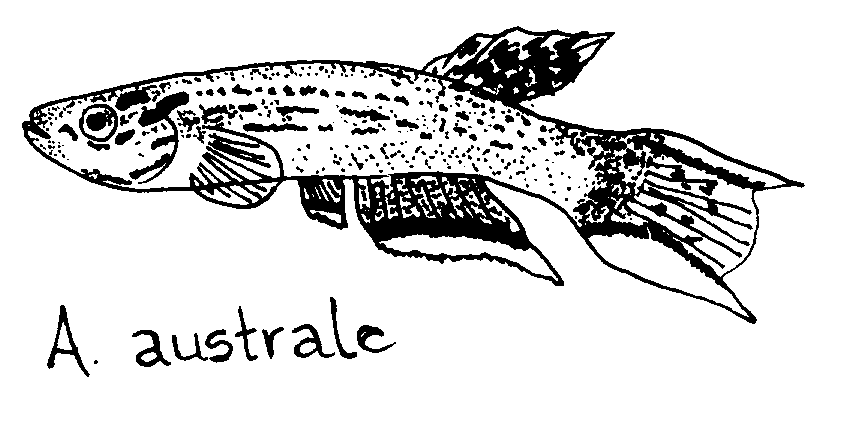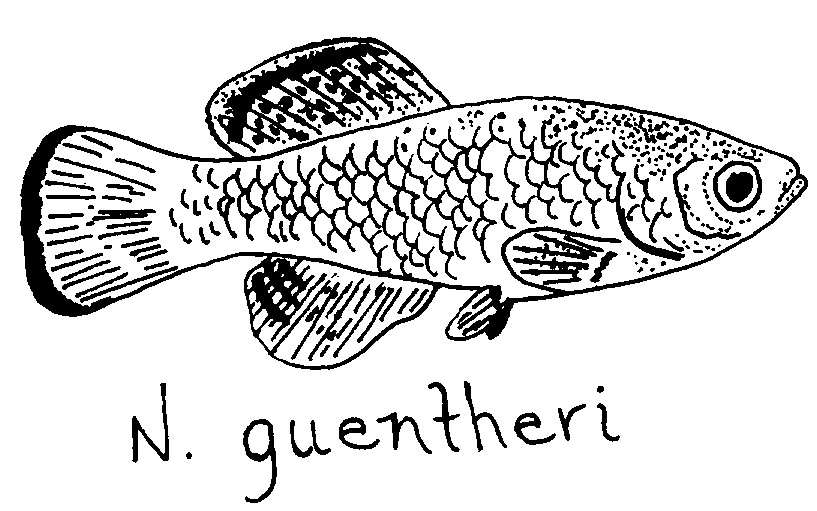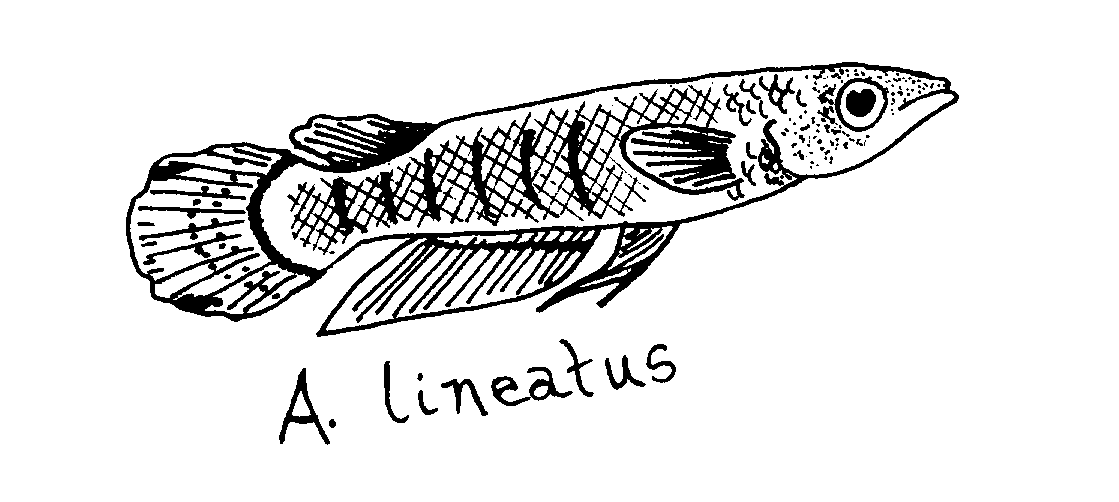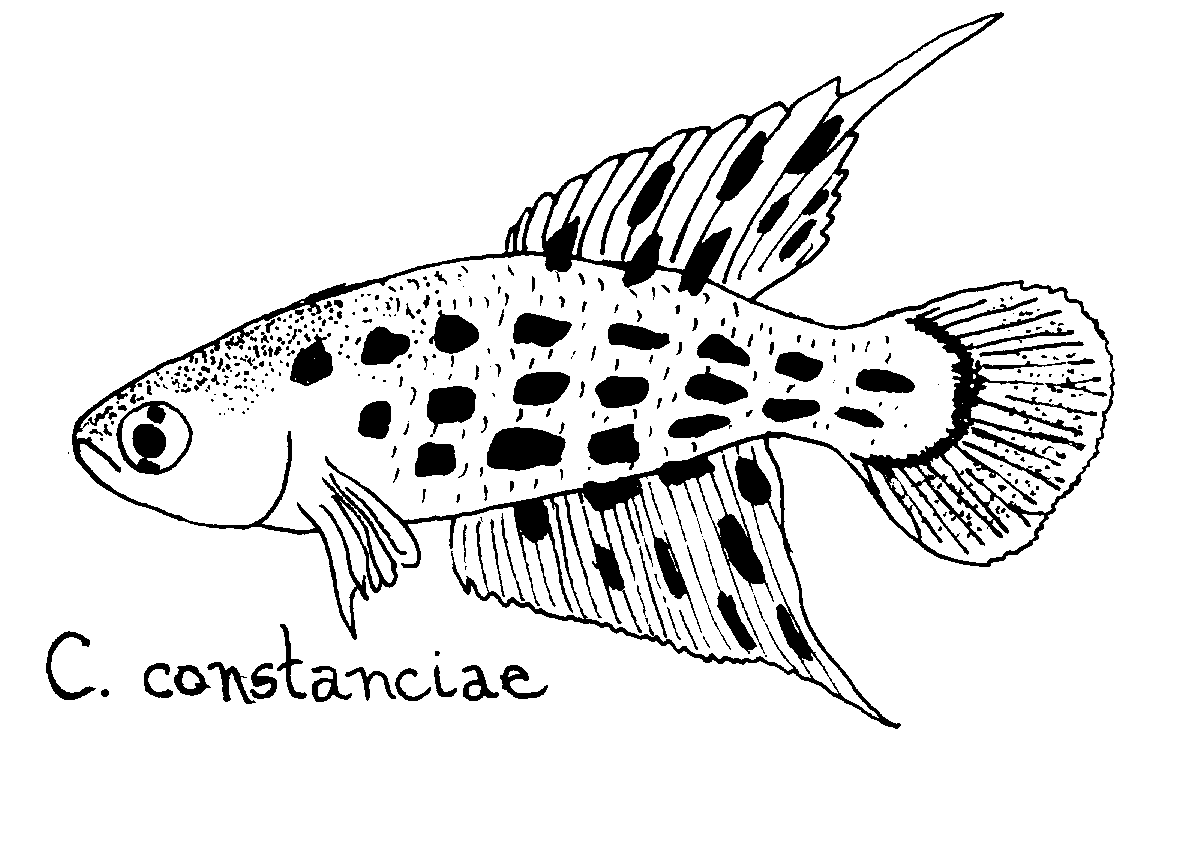Sure, I’ll bid another dollar. Those are gorgeous fish. Going, going, gone. Congratulations, you’ve just bought your first killies! Do you know what water conditions they need? How about what they eat? Who they’ll get along with? How to breed them? Any special treatment they might need?
Chances are that you got your first killifish at an auction as they are not often seen in stores in our area. If that’s the case, the name of the fish is on the bag and you are farther ahead than I was with my first killies. I found my first killies in a fish store. The tank was unlabelled, unplanted and the perhaps inch-long fry were huddled up in the corners trying to find a place to hide in a bare 30-gallon tank that had one sponge filter in the center of the floor. I couldn’t tell what genus let alone what species they were but I knew they were killies and I wanted them.
Once they were large enough to identify I was able to determine that they were Aphyosemion filamentosum. They grew into beautiful fish and I was able to spawn them and raise the fry with the advice of the club’s killie expert. I think the experience with those fish hooked me on killies for I find I’m always on the lookout for them.
Anyway, back to you and the killies you just bought. To spare you the trial by fire that I went through, let’s look at several of the more common genus of killies available. I’ll include body shapes for most of them to help in identification in case you don’t have a name for your fish but just couldn’t resist buying them.
The Genus Aphyosemion
Fish of the genus Aphyosemion have the body shape below.

They are often brightly colored fish and the tail often, but not always, sports two brightly-colored bars on the top and bottom.
Aphyosemion
originate from Central and West Africa. They are relatively undemanding and a good fish for the beginner killie enthusiast.
The smaller species such as A. australe, A. gardneri, and A. striatum grow to a size of two inches which makes them suitable for community tanks with tank mates such as cardinal and neon tetras, rummy-nose tetras, and other small non-aggressive fish such as pencilfish. They are somewhat shy and truly appreciate a top cover of duckweed or Riccia. If you are able to provide such a top cover, you will generally find your Aphyosemion resting beneath it. Small Ancistrus cats or Otocinclus can safely be added for algae control, and a few corys complete the picture.
Feeding Aphyosemion poses no particular problems. They accept flake food readily but of course relish brine shrimp nauplii, daphnia, Grindal worms, white worms, and frozen foods such as brine shrimp and blood worms. In this regard, they fit well into the community tank.
Calgary tap water is adequate for the maintenance and breeding of these fishes although their native waters are somewhat softer. I have kept and bred several Aphyosemion species in regular tap water without any difficulties. Most Aphyosemion are plant spawners (that is, they deposit their eggs on plants). The fry hatch in 12 to 20 days and are generally able to eat brine shrimp nauplii immediately after absorption of the yolk sack. In the community tank few if any fry will survive and a breeding tank is suggested if you would like to raise any quantity of fry.
I debated whether or not to include breeding information in this article as it is for novices. I decided to include a brief description for each genus because while many aquarists keep and enjoy their fish without necessarily spawning them, killie keepers almost without exception spawn their fish. With the limited availability of killies, spawning the fish is often the only way to keep in species in existence in the hobby. Besides that, it’s also lots of fun.
Breeding the plant spawners can be done several ways depending on how many tanks you want to devote to the exercise. In all methods, a tank from 10 to 20 liters is used. In one method, prepare a small tank with fresh de-chlorinated water and a sponge or box filter. The fish (the ratio of males to females is not particularly important) are put in the tank with Java moss and/or spawning mops to receive the eggs. After ten days the adult fish are removed and the eggs left to hatch. Well-fed adult fish will not generally eat the eggs. The fry can be raised in the tank until they are large enough to join the community tank or be distributed to other fish keepers. Fry are easily raised on brine shrimp nauplii and infusoria in the tank, with the addition of finely crumbled flake food when they get a little bigger. I also like to add a few adult daphnia to the fry tanks. The daphnia feed on microscopic material in the water and do not harm the fry. They constantly release baby daphnia, which the killie fry can snack on between regular feedings, once they are about two weeks old.
Another method for breeding plant spawners requires only one tank but does not produce a lot of fry. In fact, it will only maintain itself and provide a few excess fish for sale or trading. A heavily planted 20-liter tank with a thick cover of duckweed or Riccia is all that is required. Put in your pair of fish and they will do the rest. Fry hide in the thick top cover and join the adult fish when they are too big to be eaten. Don’t worry about trying to determine when that is, the little fish know when it’s safe to come out!
The Genus Nothobranchius
Fish of the genus Nothobranchius originate from the savannas of eastern Africa and are among the most brilliantly colored of all aquarium fish. I can easily see how someone would purchase this fish on an impulse; the colors are just spectacular. They need a little more care than the Aphyosemion however but are worth the effort.
The general body shape of Nothobranchius looks like this:

The colors can vary quite a bit depending on the species but generally there is a lot of red and blue. Very nice.
These fish are best kept in a species tank. A pair or trio can be housed in a 10-liter tank. A 30-liter tank can accommodate five pairs. The males can be territorial so I like to add clumps of Java fern so they can avoid each other. Our Calgary tap water is just fine for them but you must add salt to the water (about ½ to 1 tsp. per 4 liters) to prevent velvet, a fungus that will kill them quickly.
These fish will eat anything that they can manage to swallow but it must be alive. Don’t bother trying to feed them flake food. If they eat it at all it will be very grudgingly and they will not do well. The best and easiest-to-raise foods are brine shrimp nauplii, Grindal worms, and white worms.
These fish are called peat spawners or annual fish because the eggs are deposited in the mud at the bottom of the bodies of water in which they live. These bodies of water are generally temporary, appearing in the rainy season and drying up completely during the dry season. The eggs in the mud incubate during the dry season and when the rains come again and fill the pools, the eggs hatch and continue the cycle. Because their live cycles are tied to the rainy season, these fish are very short-lived. By one year old (if they live that long) they are old-looking fish with humped backs and faded colors. But while they are in their prime, wow!
Spawning them in the aquarium is relatively easy and does not require that you try to reconstruct a mud swamp. I keep my nothos in bare-bottomed tanks with the aforementioned Java fern and sponge filtration. To supply a spawning site, boiled, cooled, and rinsed peat moss is put in a yogurt container with a few small rocks in the bottom to keep it on the bottom of the tank. A hole a little bigger than a tooney cut into the lid provides access for the fish and keeps them from throwing the peat all over the tank. The fish quickly find the peat in the container as evidenced by the puffs of peat moss seen coming out of the entrance hole as they thrash around in there.
The peat should be changed at least every two weeks to prevent anaerobic bacteria from fouling the spawning media. To store the eggs for the resting period that they need, the peat is poured through a fine-meshed net and most of the moisture squeezed out. Make sure there are no fish still in the peat before you squeeze it as this is quite disastrous (as I have learned). The peat is then put in a plastic bag and the bag rolled up from the bottom. On a sticky label, write the name of the fish, the date the eggs were stored and the date the eggs should be re-moistened. Don’t just assume that you will remember these things because you won’t. The label is important. The length of time the eggs should be stored varies considerably from species to species and you will have to research the incubation time for the species you are keeping but it will probably be anywhere from three to six months. The temperature during incubation should be in the low to mid 20C’s.
When the time comes to rewet the eggs, mix up about 2 liters of water, ½ tsp. non-iodized salt and a drop of Aquari-Sol to prevent fungus on the fry. I use small Rubbermaid containers to get the maximum surface area. Unceremoniously dump in the peat and gently rub any lumps to separate them. Stir any floating peat gently to get most of it to settle and leave the whole messy-looking thing for a few hours. The fry begin hatching in a few hours and sometimes continue to hatch for about 2 days. If no fry have hatched in 24 hours, restrain the peat and incubate for another month. Removing the fry and redrying the peat for a further incubation of two weeks to a month will generally yield a second hatch of fry. Although the fry are quite small, they are generally able to eat brine shrimp nauplii as a first food and grow incredibly quickly. By six weeks old they are in glorious color and are already spawning so you can start the whole cycle all over again.
The Genera Aplocheilus and Epiplatys
Although fish of the genus Aplocheilus come from the Indio-Malayan region and Epiplatys come from East Africa the two are enough alike in the aquarium that we can deal with them as one.
The body shape of these fish looks like this:

The position of the mouth and the flat back tell us these fish are surface-dwellers. In nature they stay near the surface to hunt flying insects often jumping to catch their prey. Keep the aquarium well covered for they are good jumpers!
These are good fish for the beginning killie keeper as they are not very demanding with regard to water composition or feeding requirements. Flake food, frozen food and worms are all readily accepted. Regular, de-chlorinated tap water suites them just fine as well. They can be kept in the community aquarium but they have a nasty habit of eating any fish that will fit into their rather large mouths. I f you are considering getting some of these fish, keep in mind that some species can get up to four inches in length.
These fish have developed an interesting feature to adapt them to surface-dwelling life. On the top of their heads, there is a light sensitive organ sometimes called a third eye. While the fish cannot see shapes with this third eye, it is sensitive to light and alerts the fish to predators from above. If you pass your hand slowly over a fish resting at the surface, the light-sensitive organ alerts the fish and it will dive for cover. These fish are easily caught in the aquarium by bringing a net up underneath them. Their main focus is on what is above them with little attention paid to the water beneath.
These fish are plant spawners and for spawning purposes can be treated the same as Aphyosemion. The eggs hatch in approximately 12 to 14 days and are large enough to take brine shrimp nauplii as a first food.
The Genus Cynolebias
These are another annual peat-spawning fish but this time from South America. The genus Cynolebias is the largest genus of all South American annual killifish with a range from Brazil to almost the tip of Argentina. While not as colorful as the Nothobranchius from Africa, these fish are still very attractive and interesting to keep.
The basic body shape is similar to that of Nothobranchius but these fish sport more elaborate finnage. The drawing below is of Cynolebias constanciae, a native of Brazil.

These fish prefer live food and really won’t do well without it. Raising worm cultures isn’t all that hard and if you aren’t raising any, you should give it a try. You can raise a lot of excellent fish food with a $.99 loaf of bread and believe me, it will make a big difference to your fish! In addition to worms, brine shrimp nauplii and daphnia are excellent foods for these fish.
Temperatures should be in the low to mid 20Cs and Calgary tap water is acceptable although water a bit softer is better if you can provide it. These fish are often quite timid and a cover of duckweed will make them feel more secure.
For spawning, you can use the same type of container as with Nothobranchius but if you want to see some interesting behavior, try using a clear glass rose bowl. The male hangs out over the top of the peat and spends almost all his time trying to lure females in to spawn. The females spend their day eating and swimming around and only go near the spawning site when ready to spawn. The eggs are stored the same way as for Nothobranchius. Incubation times vary widely and you will need to find the time for your fish.
Further Reading
There are three books that I would recommend to the beginner killie keeper.
Success with Killifish,
by Edward Warner. 1977, Palmetto Publishing Company, St. Petersburg, Florida. This book is written by a hobbyist and covers such topics as water conditions, lighting, live foods, raising fry, mop and peat spawners and incubation times for several popular species. I like this book because it is written in simple terms, and puts the emphasis on critical information. The club library has a copy; check it out.
A Hobbyist’s Guide to South American Annual Killifish
by Roger Brousseau, 1994. This is another book written by a hobbyist and covers absolutely everything you could possibly want or need to know about South American annuals. The club library also has this book and I consider it a “must read” for anyone keeping these fish.
Killifish
by Barron’s Educational Series Inc., 1990. Another wonderful book by Barron’s Publishing. This book covers a wide range of topics relating to killifish of many different genera. It is easy to read and the photographs are beautiful. I’m not sure that the club library has this book but maybe if you request a copy we might just get one. ?
